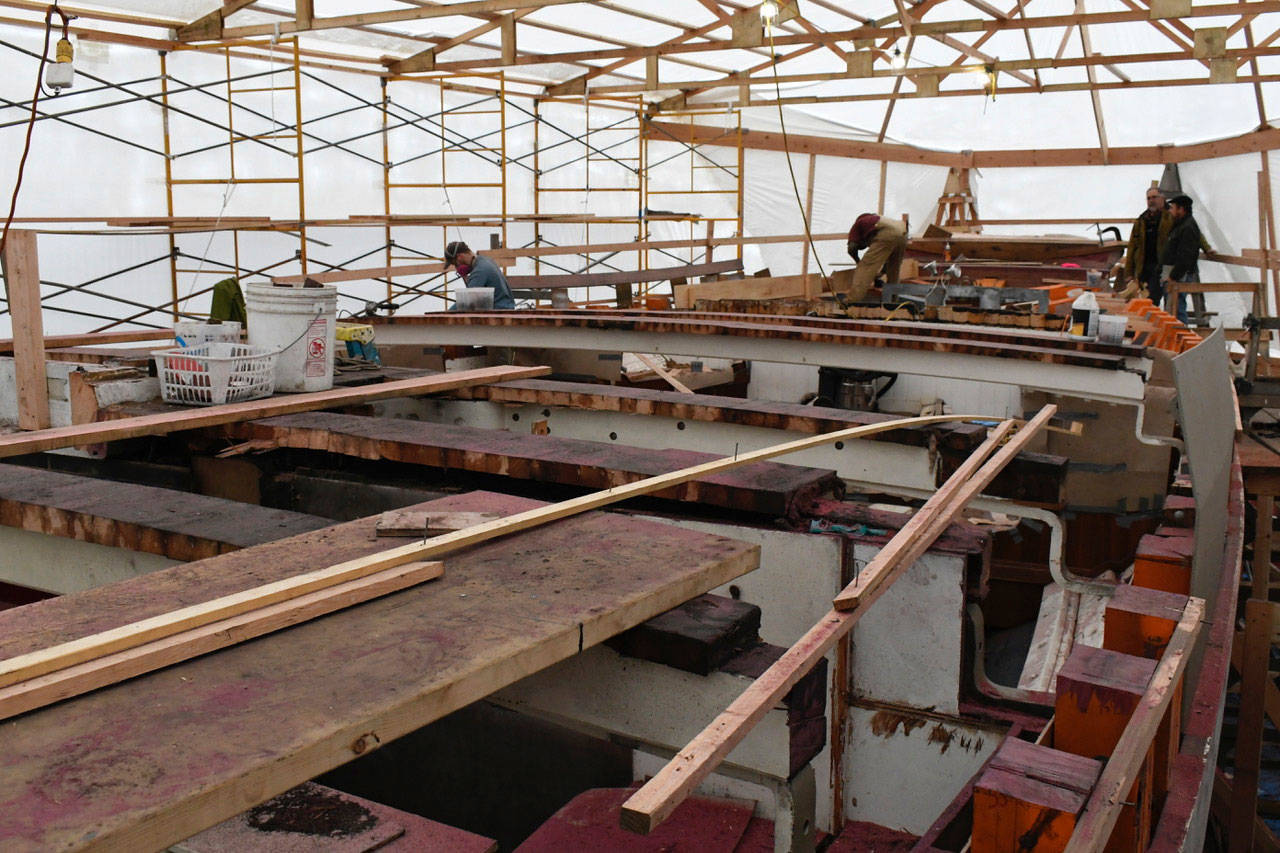PORT TOWNSEND — Local marine tradespeople are in the process of the final stage of the restoration of Adventuress, the National Historic Landmark schooner based in Port Townsend that will enter her 106th year of service in 2019.
The tall ship has undergone a decade-long restoration that cost more than $1.5 million. The Capstone Deck Project is the last piece to be completed.
The estimated $925,000 Adventuress project is being funded by a $394,000 Washington State Heritage Capital Project Fund grant, the top-ranked project in the state during the last biennium. It is also the recipient of private funding from foundations and individuals. The last $200,000 is expected to be raised by April, 2019.
Local talent and expertise are contributing to the project, said Catherine Collins, executive director of Sound Experience, a nonprofit organization that owns and operates the Adventuress as an educational, experiential, and environmental classroom on the sea.
“For the next 24 weeks, the Adventuress will be at Boat Haven,” Collins said. “This work would not be possible without the experience and skills of Port Townsend’s extensive marine trades, and Steven Gale and his skilled shipwrights at Haven Boatworks. Many are graduates of the Northwest School of Wooden Boatbuilding.
“We believe that the collective support system in marine trades, infrastructure and interest in wooden boat repair and restoration is what keeps the ship sailing for thousands of youth and the public on educational programs each year here in the Puget Sound and on the Salish Sea,” Collins said.
Blaise Holly, lead foreman at Haven Boatworks and lead shipwright on the Adventuress project, said 10 shipwrights will work on the restoration. He estimates that the team will log more than 10,000 hours of shipyard labor.
“We’ve just begun putting new pieces of wood into the boat,” Holly said.
“The deck frame, deck beams, carlins, the houses, cleats, any plumbing that was sticking through the deck, the masts — all those were quantified as interferences. We’ve removed them. Then we removed the deck using chainsaws, circular saws, and pry bars.”
“We filled a 20-cubic yard dumpster three times with that deck,” he said.
Holly said most of the wood was Douglas fir. There were some oak beams, and a little yellow pine mixed in. Most of the wood is from the original construction from 1913, and some was added during the past decade or so.
“The wood was beautiful,” he said. “The original construction was done in Maine, but they were using longleaf yellow pine that would have had to have been shipped up from Georgia and Florida and the forests of the Southeast were likely logged out by the ‘20s and ‘30s.
He said it is interesting that a yard in Maine didn’t have wood available to build a schooner the size of Adventuress.
“Either it wasn’t available physically or it wasn’t economically viable to compete with the shipping and cost of longleaf yellow pine.”
Holly remarked that history is repeating itself on this project.
“We are up against some of the same constraints here,” Holly said. “There are some tropical hardwoods being used in Adventuress partly because of their rot-resistant qualities, and partly because it is more economically viable to buy tropical hardwood from the jungles of French Guiana than it is to buy a tree that’s growing within sight of Port Townsend.”
In some ways, this reconstruction is a global venture.
Holly said the deck frame, including the beams, is being laid out in French Guiana purple heart from South America. The clamps are made from sapele, a tropical hardwood from the Democratic Republic of Congo in Africa. The decking is made of Douglas fir from one of the drainages about half-way up Vancouver Island.
“It’s traditionally laid,” Holly said, “which means it is corked with cotton and oakum made from shredded hemp. On top of that, molten pitch will be poured. That’s the way it has been done for centuries. It’s a traditional restoration.
“The only difference between the Rice Brothers in East Booth Bay and us is that we have a forklift. Other than that, the technology is almost the same.
“There would be very few pieces of usable wood that grew within a day’s drive of that Maine shipyard. It was largely imported wood then; it’s largely imported wood now.”
By early spring, Holly said Haven’s shipwrights will have replaced almost every piece of wood on the boat. Among the original wood that remains are some of the original wooden white oak floors that were in incredible shape and “there was no reason to rip them out,” Holly said.
“To me, personally, there’s a tremendous amount of pride among men and woman shipwrights,” Holly said.
“A huge part of being one is the camaraderie of working with a group of people. The historic part of that is you get to take apart a structure. You look through the details. You find different construction types on each side of a ship and see the fingerprints of the all the people involved.
“A lot of human decision making and imperfection is built into that boat. You find the drill bit the guy broke a hundred years ago and he couldn’t get it out. We are always looking for the detritus of the past when we are wrecking boats.”
More information about the Adventuress restoration, including weekly video progress updates, can be found at www.facebook.com/soundexp.
________
Jefferson County Editor/Reporter Jeannie McMacken can be reached at 360-385-2335 or at jmcmacken@peninsuladailynews.com.

